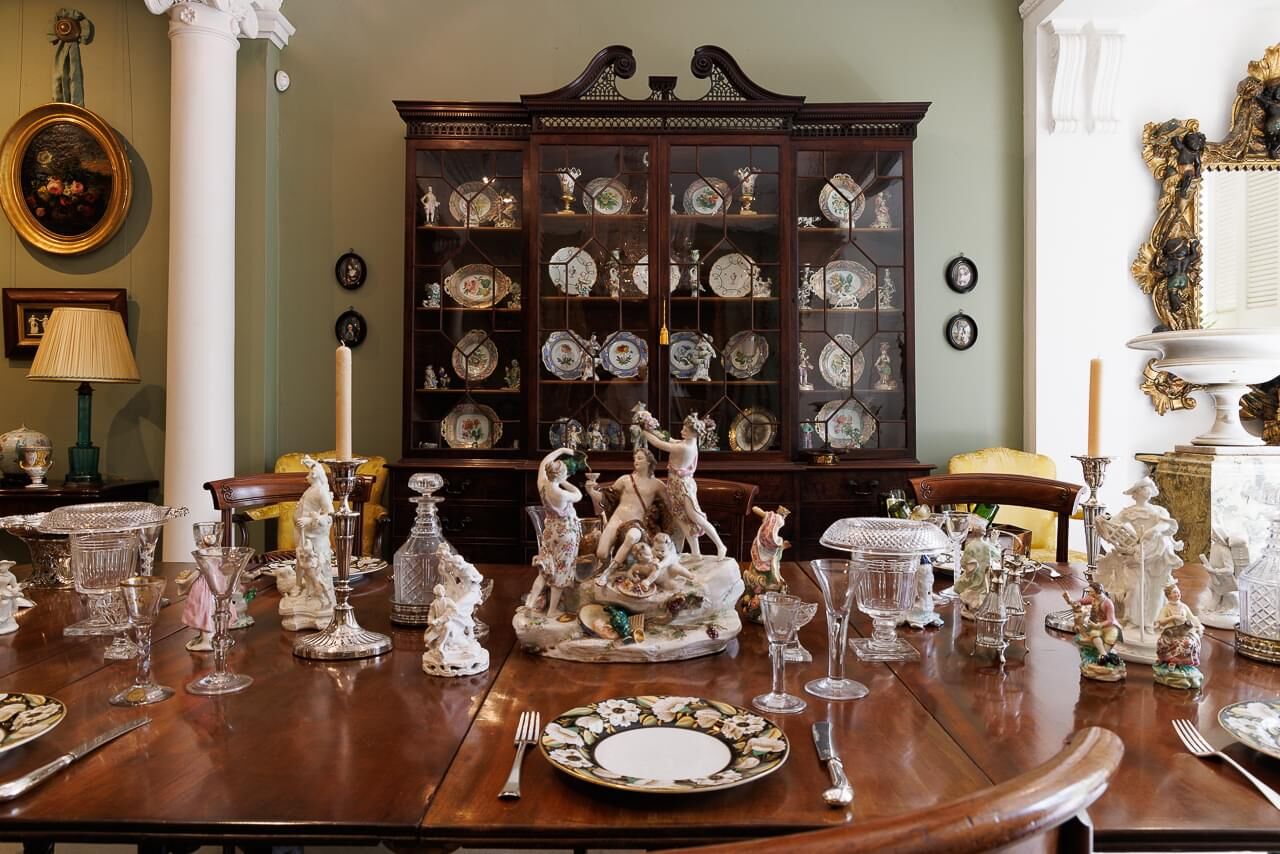A Tableau of Sugar and Porcelain: Spinning a Story

A Tableau of Sugar and Porcelain: Spinning a Story
By Rebecca Thomas
Visitors and enthusiasts of The Johnston Collection will already know it as Fairhall, an exhibition house in East Melbourne that is home to, “… a superb collection of English Georgian, Regency, and Louis XV fine and decorative arts, and objet d’art which was a gift from William Robert Johnston (1911-1986) to the people of Victoria.’[i]
A part of Johnston’s vision for the arrangement of his collection was that the displays would not be static. Both the house overall and its contents - Johnston’s residence and collection - are regularly rearranged, with works often shown alongside visiting artists and makers, thus allowing for new interpretations and the addition of new acquisitions and providing endless storytelling possibilities; an opportunity for the curator to tell new narratives.
By way of example a recent exhibition, The Real Deal[ii] took a closer look at the collection and residence in the context of Johnston as a dealer and trader, considering how he sourced and made things attractive for his customers and for himself. As part of The Real Deal, curator Dorothy Morgan created an installation in ‘The Green Drawing Room’ on the dining room table entitled: A Tableau of Sugar and Porcelain, ‘Spinning a Story’.
This tableau charted the advent of small-scale porcelain sculpture - a particular area of focus for Johnston, of which the collection boasts some excellent examples - looking at how it would eventually replace what were previously ubiquitous sugar pieces. Morgan’s use of small porcelain figures from the collection highlighted what were once an important feature of the dessert or banquet table, not only celebrated for their decorative aesthetics but also serving as a form of entertainment or as conversation starters.
By way of background, the popularity of these dining accoutrements took on against the backdrop of Georgian and Regency dining and etiquette practices. The Regency Era, a sub-period during the longer Georgian period (1714-1837), is historically and politically defined as spanning the years 1811-1820, when George, Prince of Wales, acted as ‘Regent’ throughout his father’s illness. It was during the reigns of both the Georges that Britain established herself as an international power-centre, due in part to her ever-expanding empire.
From the 1770s onwards, Britain became the world’s first industrialised nation, a period that was witness to great changes in social and economic culture: cities grew; trade and consumerism expanded; it was a time when society enabled the wealthy a flamboyant ostentatiousness in their wealth and extreme luxury; it represented the height of British style and sophistication. The way in which these changes quickly came to permeate all ways of life serves as a key illustration of the evolution in tastes and collecting occurring at this time. A readily prominent example is dining, where changes to cuisine, serving-ware, etiquette, décor, and gatherings acted as an opportunity to showcase wealth. In this context, porcelain as a luxury item came to be held in high regard for its artistic and cultural significance.
Just like Johnston the dealer, European merchants created a desire to consume the exotic which went hand in hand with consumer tastes and aesthetics and gave rise to a luxury goods market - luxuries and leisure that saw promotion through newspapers and advertising. Companies such as Wedgwood created money-back guarantees along with free delivery and endorsements by celebrities of the day to create brand awareness. It was the passions of these eras which have today left us with a legacy of architecture, artworks, and furniture.
On to porcelain then: The inexpensive porcelains that permeate our surrounds today perhaps make it difficult to grasp their original importance and regard. Marco Polo, often credited as introducing porcelain to Europe in the 14th century, was said to have been enamoured of the beautiful clay artefacts he found on his travels to China, during which time porcelain came to be known as ‘white gold’ and was even thought to possess healing properties.
Portuguese and Dutch commercial trade routes to the Far East were not established until the early 16th century. This would see porcelain become key in several early global economies – one of the first truly global products. The emergence of export-ware in Asia, coinciding with the production of porcelains made for European sensibilities and with the continuation of growth in European maritime empires, saw a constant flow of exotic goods entering the European market. The combination of greater access and an improvement to general wealth meant items such as sugar, spices, coffee, tea, silks, lacquerware, ivory, metalworks and of course porcelain, were crossing the seas and becoming more accessible to a broader part of the population.
At the same time, this greater access saw a growth in demand for porcelain across much of Europe - a booming trade that gave rise to the question of how to imitate its production so that, by the start of the 18th century, numerous attempts had been commissioned across Europe to discover its formula.
The discovery of porcelain’s secrets by Johann Friedrich Böttger (1682- 1719) – the alchemist who famously boasted that he could create gold - would have a significant impact on the European ceramic industry. The first European porcelain was produced in Dresden, Saxony in 1709 after August the Strong issued a royal decree imprisoning alchemists and potters and forcing them to work on creating porcelain. It was under these circumstances that Böttger discovered the formula and a year later full-scale production at the Albrechtsburg Castle in nearby Meissen was under way, with the factory going on to create some of the most notable porcelains even until today.
Ultimately, a lack of loyalty amongst those who had been worked under these harsh conditions saw artisans selling their production secrets to other European powers, such that less than a decade later, porcelain was being manufactured in Vienna with French, Russian and numerous other German porcelains across Europe introduced soon afterwards to compete with the Chinese and Japanese. All this notwithstanding, even after the Europeans discovered the recipe, and production took on, Chinese porcelain would remain a more desirable and, even with the cost of transport, an ultimately more affordable option.
The technical and cultural attainment achieved through this widespread manufacture would lead to porcelain taking on a critical role in many European courts, which would often sponsor their own manufacturing. This would lead to many notable artists of the time shifting their focus to the newfound medium and working towards discovering its decorative and sculptural potentials.
Interestingly, the development of porcelain production in England, whilst akin to the rest of Europe, lagged behind it by some thirty-years, its manufacture and popularity reliant upon an emergent middle and merchant class. Already a popular choice for investors as it was considered on par with silver, porcelain was introduced to the British consumer market by the English East India Company. As is often the case with big cities, English consumer trends tended to follow the tastes set in London, and this was especially so when it came to newly emerging consumption habits.
In the context of Georgian and Regency era dining, the discovery of the ‘New World’ and its corollary of more efficient trade routes led in turn to the discovery of new foods and spices: new ingredients paved the way for the creation of new recipes, which gave rise to a demand for new serving dishes such as tureens and sauceboats and the creation of centrepieces to showcase these foods. Thus, in the space of a few hundred years, dining became an important social practice, with the accompanying accoutrements - the porcelain dinnerware that had replaced the eating of meals off thick slabs of bread called trenchers - seen as a reflection of a host’s social standing. It was also a period that came to mark the height of table etiquette in Europe, with formal dinners providing the opportunity for the host to take dining to new gastronomic heights.
These formal dinners were made up of several courses, beginning with a cold course served from a sideboard and then moving on to a progression of several hot dishes from the kitchen. The meal would come to an end with what would eventually become known in today’s context as a dessert course: preserved fruits, marzipan, sugar cubes, and biscuits. This final stage of the evening was akin to a theatrical performance and was often the most elaborate and expensive of the meal, so much so that the upper classes marked the end of the main dinner service with the removal of the white tablecloth so as to provide a stark distinction between the main meal and this finale. The rules associated with dining during this era were rigid and often laden with contradictions: there were rules governing how one could enter a room, who one could sit beside, or how to drink from a cup, whereas dessert offered diners the freedom to move around the table, to sit where they liked and to discuss topics that were not considered polite dinner conversation, exemplifying a broader prevailing tension between restraint and over-indulgence, temperance and frivolous excess.
At this time, sugar was becoming a key ingredient in cooking. Inasmuch as there was little distinction during the Medieval and Renaissance periods between sweet and savoury, sugar took its place as a condiment alongside salt, oil, vinegar, mustard, and spices, used to make food more palatable. Still, sugar did have a standing as a somewhat luxe table element.
‘This came at a time when confectionary was considered as much a branch of the decorative arts as of cuisine, while porcelain for the table represented prestige as well as demonstrated power’.[iii] With centrepiece displays of intricately spun or aesthetically arrayed sugars for the dessert table, table decoration became an opportunity for grand theatrical displays. One trend for example, was to showcase the dining table as a garden.
So important was the dessert course and the need to impress that larger households would often employ the services of a French chef or confectioner. Sugar became a storytelling device, but with its delicacy and short-lived temporal nature it was only a matter of time, and industry, before it would be replaced by a more enduring and less ephemeral medium. ‘Of all the arts of the table in early modern Europe, the banquet tradition of the sugar-paste centrepiece occupies a uniquely liminal position. Capable of outlasting the meal, yet not as permanent as the tableware that surrounds it, it inserts a new temporality, at once durable and ephemeral, into the art of dining’.[iv]
Given the developments in porcelain production, this ephemerality was one of the factors that saw the once edible table displays replaced with longer-lasting porcelain sculptures. The advent of figures made from porcelain rather than sugar signified something more permanent and valuable. The range of subjects represented in 18th century porcelain sculptures encompassed the whole spectrum of contemporary society. Depictions of members of various trades and professions, and people from different parts of the globe were produced in large numbers by factories across Europe.[v] These sculptural pieces were carefully selected for the table based upon the occasion or the guests. They were not only ornamental, but also served as ‘conversation starters’ and offered a form of escapism, providing, us today with a catalogue of social orders of the day.
From the liminal ephemerality of sugar sculpture to porcelain and beyond … Food degrades, materials perish, but the art endures, and the beautiful receptacles devised to contain and enhance the pleasures of the table fortunately remain to tell us about the cultural and aesthetic preoccupations that inspired their production, and a whole lot more besides. Drawing on this for her installation, A Tableau of Sugar and Porcelain ‘Spinning a story’, Morgan’s arrangement of figures, placed outside of their traditional groupings, created new groupings that allowed for ‘new’ conversations - telling stories that perhaps nobody was talking about publicly at the time and furthermore creating a narrative better suited to a present-day audience.
Figures featuring tradespeople depict the somewhat ambiguous trend amongst the ruling classes of adopting disguises, masquerading as belonging to a lower social class. Intended as an expression of power, or representing a kink, these masquerades were criticised at the time as they were thought to promote illicit sexual behaviours. As we look at these figures today, we contemplate: are these depictions of real people going about their everyday lives or are they merely scenes involving some form of role-play?
The figure of the young woman holding flowers (A1405.1) is part of a series that depicts The Four Seasons - a recuring allegorical choice for the table, wherein the ability to recognise and recall the subject of allegorical sculptures was deemed a mark of the viewer’s education.
The figure of a singing Hurdy Gurdy player (A1388) often accompanied depictions of The Four Seasons, with the player offering the group ‘spirited’ company, with her music playing said to symbolise a harmonious relationship amongst others in the group.
Depictions of those from faraway places, like this Turkish dancer in ‘exotic’ costume (A0498), were produced in large quantities. Her presence on the table suggests a knowledge of different cultures and places. Furthermore, representations of national dress again acted as a guise for the aristocracy at masquerades, whereby playing the role of the ‘other’ was a way of expressing one’s dominance and power. The presence of a dancer also records the language of gesture: control of the body and movement was studied and observed in detail. Dance formed part of aristocratic education, along with deportment. Elegant gesture was thought to separate the classes, with many porcelains reflecting these ideals.
The presence of those from ‘foreign’ places was seen as a form of exoticism. Depictions of the ‘blackamoor’ (A1369.1) were commonplace in European art and signified dominance and luxury. In the 18th century, thousands of Africans lived in England, mostly working as unpaid domestic help.
The duo ‘Liberty and Matrimony’ (A1344.1 and A1341.2) are shown wearing rustic attire and in this instance have been placed separately on the table. The notion of the pastoral was intertwined with contemporary theatre, creating a fantasy world, and offering an escapism for the aristocracy: the notion of the Arcadian ideal, ‘where it was thought ‘rustic’ folk lived a more simple and uncomplicated life, an appealing fantasy for aristocrats who wished to escape strict conventions and protocols.’[vi] The shepherd is releasing birds, which is said to represent the freedoms of being single, while the female is holding a birdcage which suggests the social constraints of her married life.
The gestures made by the well-dressed pair (A1191.2) take on a somewhat erotic feel, given the way the shoemaker caresses the woman’s foot all whilst gazing up at her.
A popular tradition dating back to the Renaissance period saw rulers depicted as classical gods and heroes. Such mythological subjects were produced in large numbers, having gathered much momentum during the reign of Louis XIV of France, the Sun King who would often have himself depicted as Apollo. Similarly, Augustus the Strong would have himself depicted as Hercules.
A Bacchanalian scene (A0928), with Bacchus featured in the centre, draped in leopard skin and holding a cup which is being filled by one of the female attendants: this ‘theatre in the round’ centrepiece is modelled in the Rococo style; stylistically such works mark a return to the classical form.
As per the original bequest by Johnston, new acquisitions are continually being added to the collection. A recent example is this figure of Kitty Clive as ‘The Fine Lady’ (A1496). Sculptures such as this - figures featuring prominent actors of the London stage, immortalised in the roles that gave them fame - are part of a phenomenon that was prevalent amongst English porcelain factories in the mid-18th century. These pieces not only provide an insight into the development of celebrity culture during this period, but they also solidify the place of porcelain as the chosen medium for the production and circulation of popular imagery. Accompanying Kitty Clive is a figure of Henry Woodward (A1416). This ‘duo’ was sought out for the collection as they are possibly the earliest full-length portrait figures in English porcelain.
Image: Detail showing the installation A Tableau of Sugar and Porcelain ‘Spinning a Story’ seen in ‘The Green Drawing Room’ as part of THE REAL DEAL | WILLIAM JOHNSTON: His Residence & Collection, 16 March 2022 - 11 September 2022.
Journals
About US
Explore
Contact
VISIT
See our VISIT page for hours and directions
BY PHONE
+61 3 9416 2515
BY POST
PO Box 79, East Melbourne VIC 8002
ONLINE
General enquiries
Membership enquiries
Shop
Donation enquiries
Subscribe to E-Newsletter



